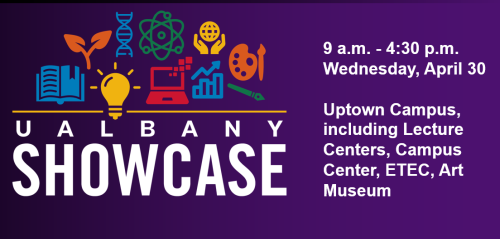Showcase 2025: UAlbany Researchers Leverage Machine Learning to Predict Depression in College Students

By Bethany Bump
ALBANY, N.Y. (April 29, 2025) — Researchers at the Center for Behavioral Health Promotion and Applied Research at UAlbany are leveraging machine learning to help identify and analyze trends in college student health and mental health.
So far, they’re finding that the models perform particularly well when predicting depression, which is one of the most prevalent mental health issues on campus. Researchers hope the data can one day be used to design interventions that help prevent symptoms from worsening over time, as those with mental health challenges often face academic struggles and are twice as likely to withdraw from college.
“These model predictions are a tool,” said Evan Ozmat, a doctoral student in counseling psychology in the School of Education who has been working with researchers at the center to conduct the analysis. “It’s just a model. It’s not Nostradamus. It’s not an oracle that’s going to tell you your future. But model predictions can be used as a stepping stone to encourage self exploration and self discovery.”
The center has been collecting data on student health and mental health for the past four years as part of Project ACCESS, a project funded by the Substance Abuse and Mental Health Services Administration that aims to reduce risk for suicide and substance use among students. The data, which are collected at specific points throughout the semester using online surveys, include questions such as age, race, gender, major and GPA, as well as health related behaviors including sexual health, substance use and gambling.
Ozmat, who obtained an IBM certification in machine learning, was aware that artificial intelligence and machine learning could be especially helpful for generating predictions and wanted to know how accurate the models could get when they were fed really high-quality data.
“I have a gaming laptop that can train these models, and I started training them using the DGX cloud system when we got access to that, and was just really impressed with the depression results,” he said. “We can predict depression scores mid-to-late in the semester with quite a high level of accuracy.”
The models are trained by giving them the answers first, Ozmat explained. Survey responses from about 400 to 500 students collected at an initial time point were compared against their actual depression scores collected at a second time point midway through the semester. The model then runs a chain of equations that can determine which combination of survey responses is most likely to predict depression for a given student.
Some variables such as gender, sense of belongingness, history of suicide attempts and mental health diagnoses are stronger predictors of depression than others, Ozmat said. But it’s also the combination of variables that matter, he said.
“The reason AI and machine learning is used in any type of setting is because of the complexity of the phenomena that you’re looking to predict,” he said. “We’re not only relying on the best predictors, but we’re relying on the best predictors and their interaction with not as important predictors.”
Researchers at the center are exploring ways this data might be used for early detection and proactive support, said Jessica Martin, associate director of the center and a research fellow in the School of Education.
“The question now is, so what do we do with this information?” she said. “If we think that a student is going to be more depressed by the end of the semester, can we develop targeted interventions for them?”
It’s especially important to consider the ethics around this question, Martin said. While targeted interventions could be as simple as sending an extra email with depression-related resources on campus and in the surrounding community, students may not want their survey data used for this purpose, she said.
“I think if and when we do anything with this, which we’re not until we figure out these ethical questions, but I think it will have to be an opt-in model,” she said. “We would have to tell students up front when they engage with our project that there’s a chance based on their screening scores we might send them additional information or invite them to complete an intervention. Students would have to know when they decide to give us data how we’re going to use that data.”
The use of AI to help with early detection of mental health challenges aligns with the center’s prevention-focused mission, she said. Identifying challenges early on can help improve mental health and academic persistence among students.
Ozmat will present findings from his analysis at UAlbany Showcase, happening this Wednesday at locations across campus. He will deliver his presentation at 12:45 p.m. in the Lecture Center Concourse, Section J.
While AI is proving to be a useful tool across many disciplines, Ozmat hopes people remember that it’s a tool that can be used in service of even more helpful human-to-human interactions.
“At the end of the day, it's not the model predictions that matter,” he said. “It’s going to be the way that those model predictions are communicated and the way that folks like peer navigators or psychologists or therapists go about using that data and working with people one-on-one.”





